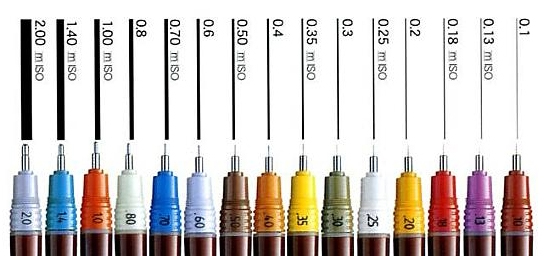Rotring
Rotring is the brand name of a type of pen for technical drawing widely used throughout much of the 20th century by architects, designers, and engineers before the advent of computer aided design. It is capable of fine precision, drawing consistent lines – as long as it is well cared for.
The classic Rotring pens were easily distinguished by their dark red barrels, narrow steel tubes in place of a conventional nib, and their use of Rotring-branded cartridge ink, making refilling a quick, clean process compared to old-fashioned methods. The pens were sometimes referred to as rapidographs, a name which came from the pen of the same name introduced by the company in the 1950s.
The Rotring company was founded in Germany in 1928 under the name Tintenkuli Handels GmbH. When it subsequently changed its name in the 1970s, it took the German term for the red ring that was placed around the pen’s barrel: rot ring.
Although such technical pens had been available in the US, they were not, initially, widely available in Europe, but Rotring’s success meant that its name eventually came to be associated with the pen type globally. Companies such as Staedtler also made similar pens which were sometimes slightly cheaper.
Rotring continues to make technical pens. However, the company’s once widespread popularity has diminished thanks to the introduction in the 1990s of computer-aided design (CAD) and the associated mechanised drafting.
Other technical pens made by the company include the Isograph. The Art Pen, while not a technical pen, has a traditional-style nib and was designed for freehand drawing and sketching. Fineline pens and propelling pencils complete the company’s line-up, along with tools to assist drafting, such as set squares, rulers, protractors and so on.
[edit] Related articles on Designing Buildings Wiki
- Architectural reprography.
- Blueprint.
- Common mistakes on building drawings.
- Computer aided design.
- Drawing projections.
- Elevations.
- Engineering drawing.
- General arrangement drawing.
- Paper sizes.
- Perspective.
- Rapid prototyping.
- Scale.
- Scale drawing.
- Technical drawing pen sizes.
- Techniques for drawing buildings.
- Types of drawings.
Featured articles and news
Government consultations for the summer of 2025
A year of Labour, past and present consultations on the environment, the built environment, training and tax.
CMA competitiveness probe of major housing developers
100 million affordable housing contributions committed with further consultation published.
Homes England supports Greencore Homes
42 new build affordable sustainable homes in Oxfordshire.
Zero carbon social housing: unlocking brownfield potential
Seven ZEDpod strategies for brownfield housing success.
CIOB report; a blueprint for SDGs and the built environment
Pairing the Sustainable Development Goals with projects.
Types, tests, standards and fires relating to external cladding
Brief descriptions with an extensive list of fires for review.
Latest Build UK Building Safety Regime explainer published
Key elements in one short, now updated document.
UKGBC launch the UK Climate Resilience Roadmap
First guidance of its kind on direct climate impacts for the built environment and how it can adapt.
CLC Health, Safety and Wellbeing Strategy 2025
Launched by the Minister for Industry to look at fatalities on site, improving mental health and other issues.
One of the most impressive Victorian architects. Book review.
Common Assessment Standard now with building safety
New CAS update now includes mandatory building safety questions.
RTPI leader to become new CIOB Chief Executive Officer
Dr Victoria Hills MRTPI, FICE to take over after Caroline Gumble’s departure.
Social and affordable housing, a long term plan for delivery
The “Delivering a Decade of Renewal for Social and Affordable Housing” strategy sets out future path.
A change to adoptive architecture
Effects of global weather warming on architectural detailing, material choice and human interaction.
The proposed publicly owned and backed subsidiary of Homes England, to facilitate new homes.
How big is the problem and what can we do to mitigate the effects?
Overheating guidance and tools for building designers
A number of cool guides to help with the heat.
The UK's Modern Industrial Strategy: A 10 year plan
Previous consultation criticism, current key elements and general support with some persisting reservations.
Building Safety Regulator reforms
New roles, new staff and a new fast track service pave the way for a single construction regulator.

























